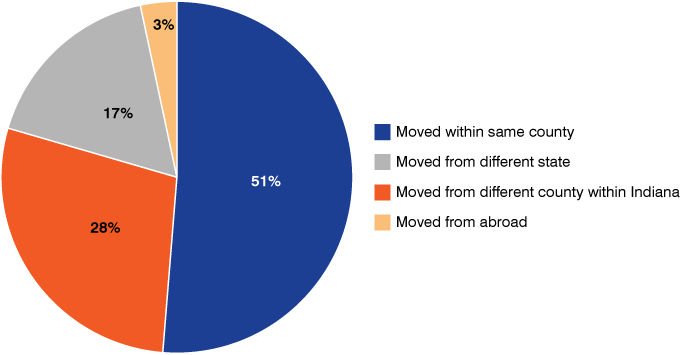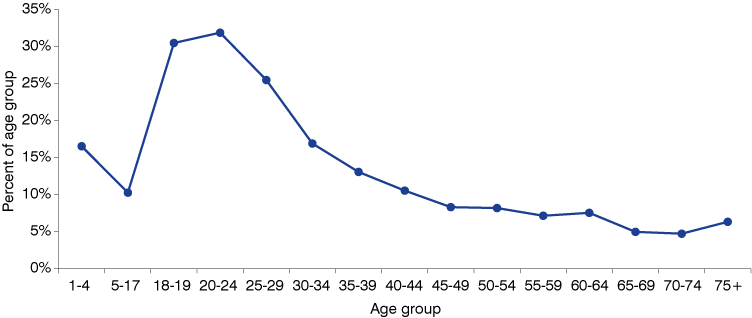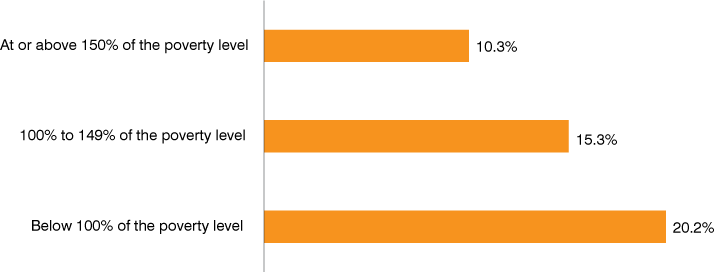Hoosiers on the move: An update 10 years later

Between 2021 and 2022, 12.9% of Indiana residents changed residences, a decrease from 13.3% in 2021, according to data from the U.S. Census Bureau.
More than 41 million Americans moved between 2021 and 2022. This resulted in a small decrease in the overall national migration rate from 12.8% to 12.6%.1
There are several explanations for this decline, including high mortgage interest rates, high median home prices, continued remote work policies and a lack of available housing. The decline in movers also extended to Indiana, where 12.9% of Hoosiers moved, a decrease from 13.3% in 2021.
As an update to Rachel Strange’s “Hoosiers on the Move” article in the March-April 2014 issue of InContext, we will use the U.S. Census Bureau’s one-year American Community Survey (ACS) estimates to help us shed some light on these Hoosier movers. Of the 870,398 residents who moved, 51% moved from within the same county (see Figure 1). Those moving from a different county within Indiana represented 28% of the movers, while 17% of the movers came from a different state.
Figure 1: Where Indiana residents moved from in the past year, 2022

Source: U.S. Census Bureau, American Community Survey 1-year estimates; table B07001
As has been the case for many years, people are less likely to move as they age.
Figure 2 shows that the 20-to-24 age group was the group with the highest percentage of movers in 2022 (31.9%) and the percentage of movers decreased with nearly every successive age group until the 75-and-over age group, which saw 6.3% of its cohort move in 2022. Unsurprisingly, the 18-to-19 age group also saw a high share of its cohort move, with 30.5% of them leaving home for various reasons.
Figure 2: Percent of Indiana population that moved in the past year by age, 2022

Source: U.S. Census Bureau, American Community Survey 1-year estimates; table B07001
There is a wide disparity between Hoosier homeowners and renters in terms of who moved in 2022. While only 8% of Hoosier homeowners moved in 2022, 24% of renters changed residences during the same time period. There is also a disparity between the married population and those who have never been married. In 2022, 8.5% of married Hoosiers moved, while 20.7% of the population that has never been married changed residences.
It is also interesting to examine an individual’s poverty status and whether or not they moved. While 10.3% of those at or above 150% of the poverty line moved in 2022, that number almost doubles to 20.2% for those below the poverty line (see Figure 3).
Figure 3: Indiana population who moved in the past year by poverty status, 2022

Source: U.S. Census Bureau, American Community Survey 1-year estimates; table B07012
As was the case a decade ago, mover rates do not differ much when analyzed through the lens of educational attainment.
Figure 4 shows that Hoosiers with a bachelor’s degree had the highest share of movers in 2022 with 11.4%, but the cohort with the lowest percentage of movers was those with a graduate or professional degree at 9.6%.
Figure 4: Indiana population who moved in the past year by educational attainment, 2022

Source: U.S. Census Bureau, American Community Survey 1-year estimates; table B07009
Learn more
To see more demographic detail for Hoosier movers, visit the Census Bureau’s data finder and search for “geographical mobility.” To compare this moving data with the article from InContext a decade ago, check out Rachel Strange’s article “Hoosiers on the Move.” For a more detailed look at the housing market and why Indiana residents seem to be staying put, check out “Closing the gap: Workforce and housing affordability" by Sara Coers in the latest issue of the Indiana Business Review.
Notes
- Ismail, Mehreen S., “Number and percentage of state-to-state movers increased between 2021 and 2022,” U.S. Census Bureau, November 21, 2023, https://www.census.gov/library/stories/2023/11/state-to-state-migration.html.
